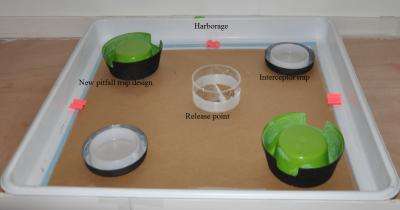New trap and lure captures bed bugs more effectively

A new pitfall trap designed to capture bed bugs is more effective than those currently on the market, according to the authors of an article appearing in the next issue of the Journal of Economic Entomology. The authors also found that traps baited with an experimental chemical lure mixture caught 2.2 times as many bed bugs as traps without the lure. Their findings suggest that an effective and affordable bed bug monitor can be made incorporating the new pitfall trap design, a chemical lure, and a sugar-and-yeast mixture to produce carbon dioxide, which is also known to attract bedbugs.
The three authors from the Rutgers University Department of Entomology, Narinderpal Singh, Changlu Wang, and Richard Cooper, report their findings in "Effect of Trap Design, Chemical Lure, Carbon Dioxide Release Rate, and Source of Carbon Dioxide on Efficacy of Bed Bug Monitors."
The new pitfall trap design was made with an inverted plastic dog bowl and the outer wall of the trap was covered with a layer of paper surgical tape which was dyed black. The lure mixture consisted of nonanal, 1-octen-3-ol, spearmint oil, and coriander Egyptian oil. Various sources and levels of carbon dioxde were also tested as attractants.
The new pitfall trap design caught significantly more (2.8-fold) bed bugs than the Climbup insect interceptor trap, which the authors name as the most effective monitor currently available on the market. Traps with the experimental lure caught 2.2 times as many bedbugs as unbaited traps. Traps baited with carbon dioxide also caught higher numbers of bed bugs, and higher rates of released CO2 were more effective than low rates. However, there were no significant differences between traps baited with CO2 derived from cylinders and CO2 derived from sugar and yeast, which is cheaper to produce.
The authors conclude that the new pitfall trap design is more effective because it is much taller than the interceptor trap, which makes it more difficult for bed bugs to escape, and that the effectiveness can be further enhanced by adding attractants such as carbon dioxide, chemical lures, or heat.
Journal information: Journal of Economic Entomology
Provided by Entomological Society of America


















